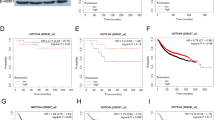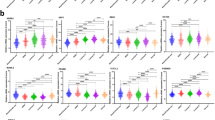Abstract
The Notch ligand, JAG1 is associated with breast cancer recurrence. Herein, we report on a genomics approach to elucidate mechanisms downstream of JAG1 that promote breast cancer growth. In a survey of 46 breast cancer cell lines, we found that triple negative (TN; basal and mesenchymal ER-, PR-, and Her2-negative) lines express JAG1 at significantly higher levels than do HER2+ or luminal (ER+) Her2− cell lines. In contrast to the luminal lines tested (T47D and MCF7), TN breast cancer cell lines (HCC1143 and MDA MB231) display high-level JAG1 expression and growth inhibition with RNA interference-induced JAG1 down-regulation. We used microarray profiling of TN tumor cells transfected with JAG1 siRNA to identify JAG1-regulated genes (P ≤ 0.005; fold change ≥1.5). Among JAG1-regulated genes identified, cyclin D1 was found to be a direct target of NOTCH1 and NOTCH3. We show that JAG1 down-regulation reduces direct binding of Notch to the cyclin D1 promoter, reduced cyclin D1 expression and inhibition of cell cycle progression through the cyclin D1-dependant G1/S checkpoint. Furthermore, we show that cyclin D1 and JAG1 expression correlate in TN breast cancer expression datasets. These data suggest a model whereby JAG1 promotes cyclin D1-mediated proliferation of TN breast cancers.






Similar content being viewed by others
References
American Cancer Society (2007) Cancer facts and figures 2007. American Cancer Society, Atlanta
Du XL, Fox EE, Lai D (2008) Competing causes of death for women with breast cancer and change over time from 1975 to 2003. Am J Clin Oncol 31(2):105–116
Miele L, Golde T, Osborne B (2006) Notch signaling in cancer. Curr Mol Med 6(8):905–918
Iwatsubo T (2004) The gamma-secretase complex: machinery for intramembrane proteolysis. Curr Opin Neurobiol 14(3):379–383
Kovall RA (2007) Structures of CSL, Notch and Mastermind proteins: piecing together an active transcription complex. Curr Opin Struct Biol 17(1):117–127
Iso T, Kedes L, Hamamori Y (2003) HES and HERP families: multiple effectors of the Notch signaling pathway. J Cell Physiol 194(3):237–255
Gallahan D, Callahan R (1987) Mammary tumorigenesis in feral mice: identification of a new int locus in mouse mammary tumor virus (Czech II)-induced mammary tumors. J Virol 61(1):66–74
Imatani A, Callahan R (2000) Identification of a novel NOTCH-4/INT-3 RNA species encoding an activated gene product in certain human tumor cell lines. Oncogene 19(2):223–231
Stylianou S, Clarke RB, Brennan K (2006) Aberrant activation of notch signaling in human breast cancer. Cancer Res 66(3):1517–1525
Yamaguchi N et al (2008) NOTCH3 signaling pathway plays crucial roles in the proliferation of ErbB2-negative human breast cancer cells. Cancer Res 68(6):1881–1888
Weijzen S et al (2002) Activation of Notch-1 signaling maintains the neoplastic phenotype in human Ras-transformed cells. Nat Med 8(9):979–986
Pece S et al (2004) Loss of negative regulation by Numb over Notch is relevant to human breast carcinogenesis. J Cell Biol 167(2):215–221
Reedijk M et al (2005) High-level coexpression of JAG1 and NOTCH1 is observed in human breast cancer and is associated with poor overall survival. Cancer Res 65(18):8530–8537
Reedijk M et al (2008) JAG1 expression is associated with a basal phenotype and recurrence in lymph node-negative breast cancer. Breast Cancer Res Treat 111(3):439–448
Farnie G et al (2007) Novel cell culture technique for primary ductal carcinoma in situ: role of Notch and epidermal growth factor receptor signaling pathways. J Natl Cancer Inst 99(8):616–627
Rizzo P et al (2008) Cross-talk between notch and the estrogen receptor in breast cancer suggests novel therapeutic approaches. Cancer Res 68(13):5226–5235
Lee CW et al (2008) Molecular dependence of estrogen receptor-negative breast cancer on a notch-survivin signaling axis. Cancer Res 68(13):5273–5281
Leong KG et al (2007) Jagged1-mediated Notch activation induces epithelial-to-mesenchymal transition through Slug-induced repression of E-cadherin. J Exp Med 204(12):2935–2948
Rustighi A et al (2009) The prolyl-isomerase Pin1 is a Notch1 target that enhances Notch1 activation in cancer. Nat Cell Biol 11(2):133–142
Sherr CJ, Roberts JM (1999) CDK inhibitors: positive and negative regulators of G1-phase progression. Genes Dev 13(12):1501–1512
Arnold A, Papanikolaou A (2005) Cyclin D1 in breast cancer pathogenesis. J Clin Oncol 23(18):4215–4224
Kiaris H et al (2004) Modulation of notch signaling elicits signature tumors and inhibits hras1-induced oncogenesis in the mouse mammary epithelium. Am J Pathol 165(2):695–705
Yu Q, Geng Y, Sicinski P (2001) Specific protection against breast cancers by cyclin D1 ablation. Nature 411(6841):1017–1021
Ronchini C, Capobianco AJ (2001) Induction of cyclin D1 transcription and CDK2 activity by Notch(ic): implication for cell cycle disruption in transformation by Notch(ic). Mol Cell Biol 21(17):5925–5934
Stahl M et al (2006) Notch1-induced transformation of RKE-1 cells requires up-regulation of cyclin D1. Cancer Res 66(15):7562–7570
Rowan S et al (2008) Notch signaling regulates growth and differentiation in the mammalian lens. Dev Biol 321(1):111–122
Campa VM et al (2008) Notch activates cell cycle reentry and progression in quiescent cardiomyocytes. J Cell Biol 183(1):129–141
Chin K et al (2006) Genomic and transcriptional aberrations linked to breast cancer pathophysiologies. Cancer Cell 10(6):529–541
Hoadley KA et al (2007) EGFR associated expression profiles vary with breast tumor subtype. BMC Genomics 8:258
Hu Z et al (2006) The molecular portraits of breast tumors are conserved across microarray platforms. BMC Genomics 7:96
Miller LD et al (2005) An expression signature for p53 status in human breast cancer predicts mutation status, transcriptional effects, and patient survival. Proc Natl Acad Sci USA 102(38):13550–13555
Neve RM et al (2006) A collection of breast cancer cell lines for the study of functionally distinct cancer subtypes. Cancer Cell 10(6):515–527
Richardson AL et al (2006) X chromosomal abnormalities in basal-like human breast cancer. Cancer Cell 9(2):121–132
Barrett T et al (2007) NCBI GEO: mining tens of millions of expression profiles—database and tools update. Nucleic Acids Res 35(Database issue):D760–D765
Choi JH et al (2008) Jagged-1 and Notch3 juxtacrine loop regulates ovarian tumor growth and adhesion. Cancer Res 68(14):5716–5723
Jundt F et al (2004) Jagged1-induced Notch signaling drives proliferation of multiple myeloma cells. Blood 103(9):3511–3515
Purow BW et al (2005) Expression of Notch-1 and its ligands, Delta-like-1 and Jagged-1, is critical for glioma cell survival and proliferation. Cancer Res 65(6):2353–2363
Santagata S et al (2004) JAGGED1 expression is associated with prostate cancer metastasis and recurrence. Cancer Res 64(19):6854–6857
Dent R et al (2007) Triple-negative breast cancer: clinical features and patterns of recurrence. Clin Cancer Res 13(15 Pt 1):4429–4434
Lee CW et al (2008) A functional Notch-survivin gene signature in basal breast cancer. Breast Cancer Res 10(6):R97
Bane AL et al (2008) Expression profiling of familial breast cancers demonstrates higher expression of FGFR2 in BRCA2-associated tumors. Breast Cancer Res Treat 117(1):183–191
Osipo C et al (2008) ErbB-2 inhibition activates Notch-1 and sensitizes breast cancer cells to a gamma-secretase inhibitor. Oncogene 27(37):5019–5032
Sherr CJ (1996) Cancer cell cycles. Science 274(5293):1672–1677
Wang TC et al (1994) Mammary hyperplasia and carcinoma in MMTV-cyclin D1 transgenic mice. Nature 369(6482):669–671
Elsheikh S et al (2008) CCND1 amplification and cyclin D1 expression in breast cancer and their relation with proteomic subgroups and patient outcome. Breast Cancer Res Treat 109(2):325–335
Doisneau-Sixou SF et al (2003) Estrogen and antiestrogen regulation of cell cycle progression in breast cancer cells. Endocr Relat Cancer 10(2):179–186
Aaltonen K et al (2008) Cyclin D1 expression is associated with poor prognostic features in estrogen receptor positive breast cancer. Breast Cancer Res Treat 113(1):75–82
Umekita Y et al (2002) Overexpression of cyclin D1 predicts for poor prognosis in estrogen receptor-negative breast cancer patients. Int J Cancer 98(3):415–418
Palomero T et al (2006) NOTCH1 directly regulates c-MYC and activates a feed-forward-loop transcriptional network promoting leukemic cell growth. Proc Natl Acad Sci USA 103(48):18261–18266
Acknowledgments
The authors would like to thank members of the Reedijk Lab for valuable advice and support. This study was supported by funds to M.R. from the Canadian Breast Cancer Foundation. Analyses were performed using BRB-ArrayTools developed by Dr. Richard Simon and BRB-ArrayTools Development Team.
Author information
Authors and Affiliations
Corresponding author
Electronic supplementary material
Below is the link to the electronic supplementary material.
Rights and permissions
About this article
Cite this article
Cohen, B., Shimizu, M., Izrailit, J. et al. Cyclin D1 is a direct target of JAG1-mediated Notch signaling in breast cancer. Breast Cancer Res Treat 123, 113–124 (2010). https://doi.org/10.1007/s10549-009-0621-9
Received:
Accepted:
Published:
Issue Date:
DOI: https://doi.org/10.1007/s10549-009-0621-9




